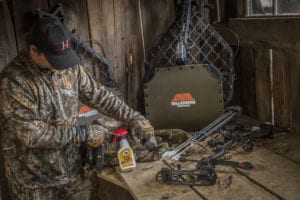
by Dan Carlson
Deer seasons are wrapping up around the country and that means it’s time to collect your gear and begin planning for deer hunting in 2020. Those plans begin as you descend from your tree or clean up your blind to wrap up the current season. Sadly, many hunters don’t invest much time in caring for their gear now and end up regretting that decision next fall.
You’ve invested money in your deer stand and time in learning how to use it. With proper care it will last a lifetime. But as is the case with any piece of equipment, failure to properly maintain and care for your treestand can reduce its service life and even render it unfit for use.
The first step in post-season care is to remove your treestand from the tree. This may sound obvious but many hunters choose to leave treestands mounted in trees over several seasons. This could not only harm the tree as it grows, but can also weaken the treestand over time. I was discussing this with a fellow hunter last month and he told me he’s encountered treestands with two to three years of growth enveloping portions of the stand. This can easily happen if a hunter forgets where the stand was mounted, has a life experience that prevents him/her from hunting next year or doesn’t draw a tag the next season or two. As conservationists, we hunters have an obligation to manage forest resources responsibly so please take the treestand down.
Once you get the treestand home, perform routine maintenance. Closely inspect all cables and straps. Look for signs of wear, breakage and stretching. Replace any that concern you. Also inspect all screws and bolts for evidence of corrosion or loose components. Tighten any that need it. Be certain to check the stitching on all straps and harnesses as well.
Resist the urge to spray or rub oil, grease or other protecting lubricants on your treestand prior to storage in order to prevent rust. Millennium treestands are powder-coated to prevent corrosion and should only need a good rub down with a soft cloth prior to being put away. The problem with oils is their scent, which can work its way into hard-to-reach places and be difficult to remove. There’s a risk deer will smell it next fall.
Speaking of scent, many hunters have started using ozone-generating devices to deodorize clothing and hunting-related gear made of cloth or textiles. This is highly effective because the process attacks and neutralizes odors at the molecular level. Given the sensitive nature of deer noses, it can’t hurt to deodorize the seat components of your treestand. NOTE: Some materials are degraded by exposure to ozone, nylon being an example of one. Do not use ozone to deodorize straps or safety harnesses. Be sure to check on the textiles in your treestand to find out their compatibility with ozone, and it’s considered unwise to use ozone on climbing or sitting safety harnesses just to be on the safe side. If you don’t have an ozone generator, consider spraying down the seat and textile components of your gear with one of the many fine odor-suppressing/masking/eliminating products available where you buy hunting gear.
Another way to mask any odors accumulated by your treestand during the season is to store it in a bag or container with fresh-cut cedar boughs. This will infuse your stand with the smell of cedar but that should be okay in most hunting environments as it doesn’t seem to spook game.
Don’t store your treestand outside and unprotected. All manner of undesirable things can happen between seasons such as pets urinating on it, accumulations of scents from surrounding activity such as automobiles and lawnmowers, and inevitable degradation from exposure to UV-rays from the sun. There’s also the threat of damage from rodents and insects outside.
If possible, avoid storing your treestand in the garage unless you put it in an airtight container. The garage hosts a variety of scents game associates with humans such as gas, oil, exhaust, pet smells, weed killers and fertilizer. And rodents have also been known to get into garages where treestands are just another thing for them to gnaw on.
The best options for treestand storage during the off-season months are the basement of a home or a well-constructed storage shed free of rodent activity, moisture and chemical smells. Even in these areas, wrapping the treestand or keeping it in a designated container are preferable to leaving them out.
Hopefully, this blog post has served as a reminder of things to consider as your deer season winds down. It’s always prudent to remember that a little work and preventive maintenance now can prevent a lot of frustration and disappointment next hunting season.

